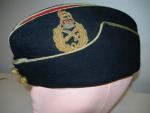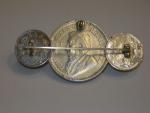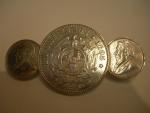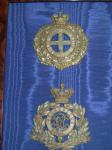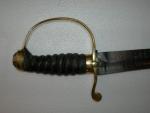-
Posts
13,225 -
Joined
-
Last visited
-
Days Won
22
Content Type
Profiles
Forums
Blogs
Gallery
Events
Store
Everything posted by Mervyn Mitton
-
Back view - you will note that in addition to the pin, there is also a suspension loop at the top for a necklace.
-
During the Boer War (1899-1902) the British had a problem with where to keep prisoners of war. With our large Empire there were plenty of places to send prisoners and eventually St.Helena , Bermuda, Ceylon and India had large camps established. The prisoners were allowed craft work to entertain themselves and this prisoner-of-war art had some beautiful and creative pieces made. They were allowed small knives and used locally available materials. Items ranged from chairs, jewellery, love tokens for wives or, sweethearts and virtually every other small object that you can think of. Most prisoners had coins in their pockets when captured and the silver ones were very popular. Smaller coins would be melted down to act as solder and if a fastener was required they would make the clasps from silver and use a large safety pin. The pins are often rusted and as in this example have to be replaced. The coins used for this brooch are two 6d pieces - 1893 and 1895 - and the 2/6d is dated 1895. All have Paul Kruger's head - as President of the 2nd Boer Republic. All of this POW art is now valuable and prices have gone up substantially in recent years - many of the main collectors are in the US.
-
Will - Hi ! Interesting that you were in the Guard. Do you have a picture of that dreadful turquoise tunic - as Arthur said - very incongruous. Mervyn
-
Dear Will These old photographs are so valuable for info. - I think it is the first time a have seen a close-up for CP in this detail. I bought yesterday a very nice group to Cape Police District 1 - Cape of Good Hope GSM - one bar , Bechuanland + 2 bar QSA and King's. I will post it when I sort the computer out. Best wishes Mervyn
-
Glad it revived memories - and excellent data for members on the chronology. I'm guessing you may have had something to do with the unit ? Mervyn
-
Two uncommon Australian Helmet Plates - intended for the blue infantry pattern helmet. The top one is for the State of Victoria Military Forces - the second one for State of Queensland. This on is very unusual in that it has the lead seal on the reverse to show it's acceptance by the purchases board. When they had the seal they became the pattern that all other manufactured ones had to follow. Both would have been fire gilt , but over the years it has faded back. Mervyn
-
Side view - showing height of ostrich plume
-
This is a very interesting South African shako - worn by the State President'd Guard until the change over in 1994. This was worn during normal parades and guard postings - for ceremonial occasions there was a white pith helmet , with spike, however, both used the same enamel badge. They have become rare.
-

Bristol Helmet
Mervyn Mitton replied to Jamie770's topic in Great Britain: Mervyn Mitton's British & Colonial Police Forces
Very similar to the pattern from Wales that also used the metal chin strap. I would say pre-1stWorld War. I have never seen this style for Bristol - you are breaking new ground. Have you researched it at all ? Incidentally - you gave dates for George V1 on your Ch.Supt's helmet - but, from what I can see on the angle, the cypher looks like George V ? -
The interwoven leather strap is not common and I hadn't known that Cambridgeshire used it as standard. With the collection still being mainly in UK I was working from a small camera picture and couldn't see the detail. Machine sewn straps are the norm - sometimes a rivet. My spare truncheon was a lovely lignum vitae example given to my Father as a special during the Great Strike of 1926. The strap had perished so I had a dog lead cut down and sewn on - I was the only one with a blue strap ! All original truncheons were in three different woods - lignum vitae; teak and ebony. None of them float in water and don't shatter . Most are over 100 years old - in the early 70's they started to replace damaged ones with rosewood - and as you so rightly say, they are light and break easily - not that it matters with the new commando style. I say that because in the the 1960's I visited Berlin and bought the identical style - it was shown as being issued to the West German army. Mervyn
-
Ranks above Inspector always wore patent leather sword slings - basically to show officer rank. The actual carrying of swords was discontinued in Victorian times. I have just sold to a collector one of this pattern sword - based on the artillery. Are you associated with the police in any way or, just have the interest? I'm only being nosy - there aren't that many collector's with your quality of pieces. Mervyn
-
Dear Jamie - you have a great collection - the condition of the ones you have shown are exceptional. Hard to say exactly for dates, however your Newcastle is prob. George V and therefore, could be as early as 1910. Edward crowns are often more angular. The Edinburgh one has a superb silver gilt plate - worth a fortune in itself.Do you have other police material ,or, have you specialised in headgear. Look forward to seeing other posts. Mervyn
-
The Met. Police Inspectors and above wore helmets on major parades - i.e. Trooping the Colour. These were issued, but only inner divisions - under 5000 men were called on for these events. The inspectors pattern still had the chin chain, and was not so elaborate. This one has the 'furniture' in silver and with a rope pattern. The Commander of the parade - remember, it may be a military event, but, under police control - was usually an Asst. Comm. who wore a cocked hat with plumes, a heavily embroidered tunic with austrian cording. A ch.supt. would have a similar tunic, but not so ornate. Inner div. P.C.'s were issued with No.1 dress - this buttoned to the collar and had buttons on the pleated rear - we wore white gloves. When they were withdrawn in 1973 the Met sold them at ?3.50 to Elstree film studios !!!! You rarely see helmets of this quality and it has to have a value of about, ?750.
-
Wasn't sure if this one should be under Swords - however, it is specifically for the police. Very few people realise that the early British police were armed - we mostly associate them with wooden truncheons. The fact is that in the 19th.century policing was a very dangerous occupation - there was no proper street lighting , no way to call for help (apart from a rattle) and the criminal element were armed and willing to use their weapons. The first policeman was killed only a few weeks after they first went on duty in 1829 - he was stuck head first into a drain ! Swords - and pistols - were mostly kept in the Station - to be issued in an emergency - they were issued on a regular basis to P.C.'s on dangerous beats. One of the most frightening must have been graveyard duty. To guard against body snatchers - or, as they were known, Resurrection Men, police patrolled cemetries at night. Grave robbers would dig-up recently buried corpses and sell them to medical schools and as a lot of money was involved they were violent. The sword shown here was supplied by Parker Field - armourers to the Metropolitan Police and dates between 1840 and the 1870's - although this pattern was for County Forces - the Met. having their own style. I will post one of those another time. Mervyn


